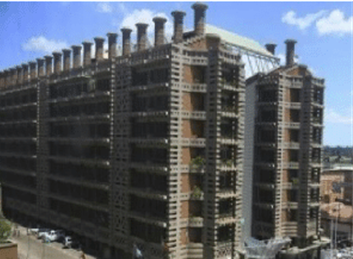Biomimicry: Applications in Architecture
Biomimicry: Applications in Architecture
“Come forth into the light of things, let nature be your teacher”
William Wordsworth
The great poet rightly said that the nature is first and foremost teacher. The teacher who is eternal and has a lot to deliver in terms of resources, wisdom, facts and beyond.
The nature comprises biotic and abiotic components
and their interrelationship. The forms and functions of these components are well integrated with
their surroundings. Bio-mimicry is a practice which enhances connection
between human and nature. Adopting these practices in architecture make
positive impact on human mind and behavior.
What is a Bio mimicry?
Biomimicry is a practice to learn,
understand, analyze and adopt the strategies found in nature. It’s all about mimicking the natural forms,
processes, systems for resolving human challenges in strategic way.
The forms of natural elements
support their own functions. The processes in nature are effective and
efficient to fulfil needs in their own capacities. The systems in nature
are symbiotic and context responsive.
All are interconnected and hence sustainable.
Why Biomimicry?
The nature has survived since 3.8
billion years and evolved consistently and hence we consider as a teacher with
eternal wisdom. It comprises several elements, ecosystems which have their own
characteristics and connectedness to respond the surrounding. These responses
ensure the sustainability of their own as well as their ecosystems. The
responses are form-based, process- based and system based.
By studying their responses, we can learn to develop the strategies for new products, processes, systems, or improve the existing ones. These strategies may prove more practical, innovative and sustainable.
Function, Strategy and Context
·
Function defines the purpose or
outcome of the product … It answers the question What?
·
Strategy is a
methodology or process to accomplish the function as…It answers the
question How?
· Context refers situation
or location in which the product is being utilized… It answers the question
Where and When?
Example: Birds’ Nests
Examples of Bio mimicry
In Bio mimicry forms, processes and systems
are imitated strategically to resolve human challenges.
· Mimicking the forms: Shape, Surface, Texture
Every organism has a certain form that allow
that organism to carry out it’s functions efficiently and effectively in their
context. Studying the form and functions of the organism we can adopt them for
similar kind of design.
Architectural Application: The Gherkin London
The forms of biotic and abiotic components are
derived as per their contextual settings. The forms are outcomes of adaptation
and evolution of those components and hence they are resilient. This is one of
the fundamentals of survival and sustainability.
Venus Flower Basket is a spongy marine creature. The
form of this creature is cylindrical and tapering to both the ends. The
structure is a network of horizontal, vertical and diagonal spikes which makes
this spongy creature more stable and stronger against the water currents in seas
ad oceans.
Gherkin skyscraper is similar to the Venus Flower basket in terms
of form, structural system. The cylindrical form allows air to flow around it
more easily and quickly than the conventional angular form of the building. The
structural system and architectural form are in perfect synergy ensures
resilience against wind loads and seismic loads.
·
Mimicking the processes:
Operation or Behavior
Living organisms and nonliving elements in
nature are interdependent and follow certain processes for their functions.
These processes are their biophysical necessities and context responsive. This
is a great learning and can be adopted for built environments for any given
location.
Architectural Example: Eastgate Centre, Harare,
Zimbabwe.
Termite mounds house the termite community underground. The
design of the mounds has its uniqueness in terms of thermal comfort. Internal
temperature of these mounds is 300C though the ambient temperature
is 10C-400C. The stack effect in mounds effectively
regulates inside temperature.
Eastgate Centre, located in Harare, Zimbabwe has adopted the
similar principal of heat exchange. In the evening when external temperature
drops the cool air enters through the bottom inlets and warm air is vented out
through vents located at the building terrace. This uses less than 10% of
energy than that of conventional building of same volume.
·
Mimicking the systems: Collaboration
between Many Forms and Processes
Nature comprises several ecosystems which are
intra as well as interdependent in terms of their functions. These functions
efficiently work when the surrounding conditions are conducive. The extent of
this conduciveness is at micro to macro level. i.e. local, regional as well as
global level.
Architectural Example: Integrated Township
Honeycombs are a community housing of created by honeybees which are self-sufficient and context responsive. Honeycomb is a mass of hexagonal cells made up of wax. Honeybees keep their brood, store honey and pollens into it. Roll of honeybees in pollination is primary which keep surrounding ecosystems intact. Interdependency between honeybees, their surrounding and human life is significant.
Integrated Townships are a symbiotic development and
an ecosystem of their own. It comprises residential, economic activities,
compatible infrastructure (physical and social), sustainable transportation
systems etc. All these factors are interdependent and efficiently maintained
without compromising environmental quality.
The
learnings for architects……
Ø to respond to context and local conditions
by deriving the forms
Ø to regulate the processes by
optimizing the resources
Ø to restore the systems by managing
the resources
Applications of biomimicry in architecture
domain simply make wonders in terms of forms, processes and systems. United Nations (UN) declared Sustainable
Development Goals 17 (SDG 17) in 2015. These goals can be achieved in large
extent if we architects learn from nature to design the built environment which
lead to sustainability.
…Biomimicry is a Source of Information and Inspiration for Innovative Solutions in Architecture…
Ar. Aditi Sontakke
Associate Professor
TSAP, Mumbai
HSC in Science Stream, with 50% Aggregate and 50% Aggregate in PCM.
Qualifying Entrance Exam: NATA or JEE-Paper II
(For any details contact us)
Website: www.tsapmumbai.in
E-mail: tsap@thakureducation.org
Contact: 022-67308001/02
WhatsApp: +91-9833665446












"What a fantastic find! The architect's blog post is a goldmine of information – every paragraph is filled with valuable insights. The way they break down complex concepts and provide practical applications is truly commendable. This is the kind of content that makes learning enjoyable and enriching. Thank you for sharing your Architects in Arkansas!"
ReplyDelete